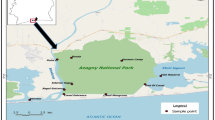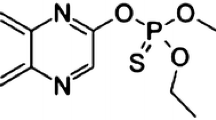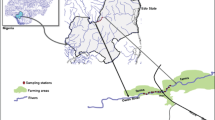Abstract
This study reports evidence of increased chlorpyrifos contamination in sediment and water in Lake Naivasha following its intensive application in the horticultural farms in the catchment area. Analytical results show that levels of chlorpyrifos residues were influenced by climate-induced rainfall pattern with higher levels reported during period of heavy precipitation with significant decrease during low rainfall. On average, the levels ranged between 14.8 and 32.8 ng g−1 in sediment during rainy season compared to a range of 8.5–16.6 ng g−1 in the dry season. Additionally, the mean concentration of chlorpyrifos in water ranged between 8.61 and 22.4 μg L−1 during rainy season and below detection limit (bdl) −13.6 μg L−1 in dry season as quantified by enzyme-linked immunosorbent assay. Meanwhile, independent t test analysis indicated that there was significant difference in concentration at p ≤ 0.05 between the seasons with respect to sediment and water samples. This demonstrated that climate-induced variations had considerable influence on contamination. While diazinon and carbofuran were equally applied intensively, their levels were below the detection limit in the all the samples analyzed. ELISA results were validated by the capillary-HPLC photodiode-array detector instrument analysis, and statistical comparison showed no significant difference between them. It was evident that chlorpyrifos residues determination in water and sediment by ELISA can be a useful strategy in environmental management and monitoring program, and a complimentary analytical tool to high performance liquid chromatography. Levels of chlorpyrifos detected in sediment and water were found to exceed recommended criteria for protection of aquatic life and preservation of water quality and may be hazardous if not regularly monitored.



Similar content being viewed by others
References
Bailey, H. C., DiGiorgio, C. L., Kroll, K., Miller, J. L., Hinton, D. E., & Starrett, G. (1996). Development of procedure for identifying pesticide toxicity in effluents and ambient water: carbofuran, diazinon, chlorpyrifos. Environmental Toxicology and Chemistry, 15, 1837–1845.
Banks, K. E., & Hernandez, S. (2003). Evaluation and validation of commercially available enzyme linked immunosorbent assays (ELISAs) specific for atrazine chlorpyrifos, and diazinon in aqueous phase. Talanta, 61, 257–265.
Becht, R., & Harper, D. M. (2002). Towards understanding of human impact upon hydrology of Lake Naivasha, Kenya. Hydrobiologia, 488, 1–11.
Bland, J. M., & Altman, D. G. (1986). Statistical method for assessing agreement between two methods of clinical measurement. The Lancet, 1, 307–310.
Bloomfield, J. P., Williams, R. J., Gooddy, D. C., Cape, J. N., & Guha, P. (2006). Impacts of climate change on the fate and behavior of pesticides in surface groundwater. A UK perspective. Science of the Total Environment, 369, 166–177.
Bondarenko, S., Gan, J., Haver, D. L., & Kabashima, J. N. (2004). Persistence of selected organophosphate and carbamate insecticides in water from a coastal watershed. Environmental Toxicology and Chemistry, 23(11), 2649–2654.
Burgoa, B., & Wauchope, R. D. (1995). Pesticides in run-off and surface waters (p. 342). Chinester: Environmental behavior of agrochemicals.
Carr, R. L., Ho, L. L., & Chambers, J. E. (1997). Selective toxicity of chlorpyrifos to several species of fish during an environmental exposure: biochemical mechanisms. Environmental Toxicology and Chemistry, 16(11), 2369–2374.
Domagalski, J. L., & Kuivila, K. M. (1993). Distributions of pesticides and organic contaminants between water and suspended sediment, San Francisco Bay, California. Estuaries, 16(3A), 416–426.
Dubrovsky, N. M., Kratzer, C. R., Panshin, S. Y., Gronberg, J. M., & Kuivila, K. M. (2000). Pesticide transport in the San Joaquin river basinm agrochemical fate and movementperspectve scale and study. Amercian Chemical society, Washington D.C.
Dyk, J. S., & Pletschke, B. (2011). Review on the use of enzymes for detection of organochlorine, organophosphate and carbamate pesticides in the environment. Chemosphere, 82, 291–307.
Ensminger, M., Bergin, R., Spurlock, F., & Goh, K. (2011). Pesticide concentrations in water and sediment and associated invertebrates toxicity in Del Puerto and Orestimba Creeks, California, 2007–2008. Environmental Monitoring and Assessment, 175, 573–587.
Gitahi, S. M., Harper, D. M., Muchiri, S. M., Tole, M. P., & Ng’ang’a, R. N. (2002). Organochlorine and organophosphates pesticide in water, sediment and selected organisms in Lake Naivasha (Kenya). Hydrobiologia, 488, 122–128.
Helfrich, L.A., Weigmann, D.L., Hipkins, P., & Stinson, E.R. (1996). Pesticides and aquatic animals: a guide to reducing impacts on aquatic systems. Virginia Cooperative Extension. Accessed on 12-05-2012.
Howard, P. E. (1989). Handbook of environmental fate and exposure data for organic chemicals, I: large production and priority pollutants (pp. 574–580). Chelsea: Lewis Publishers.
Huber, A., Bach, M., & Frede, H. G. (2000). Pollution of surface waters with pesticides in Germany: modeling non-point sources inputs. Agriculture, Ecosystem and Environment, 80(3), 191–204.
Hunt, J. W., Anderson, B. S., Phillips, B. M., Nicely, P. N., Tjeerdema, R. S., Puckett, H. M., et al. (2003). Ambient toxicity due to chlorpyrifos and diazinon in a central California coastal watershed. Environmental Monitoring and Assessment, 82, 83–112.
Hunt, J. W., Brian, S., Anderson, B. S., Phillips, B. M., Tjeerdema, R. S., Richard, N., et al. (2006). Spatial relationship between water quality and pesticide applications rates in agricultural watersheds. Environmental Monitoring and Assessment, 121, 245–262.
IPCC United nation Intergovernmental Panel on Climate Change (2007). Climate Change: Physical sciences basis, Cambridge, UK: Cambridge University press. http://www.ipcc.ch/ipccreports/assessment-reports.htm. Accessed on 22 March 2011.
Jamal, G. A. (1997). Neurological syndromes of organophosphorus compounds. Adverse Drug Reaction Toxicology Review, 16(3), 133–170.
Kawamoto, T., & Makihata, N. (2003). Development of a simultaneous analysis method for carbofuran and its three derivative pesticides in water by GC/MS with temperature programmable inlet on-column injection. Encyclopedia of Analytical Science, 19, 1605–1609.
Kenya Meterological Department, (2010). http://www.meteo.go.ke. Accessed on 20th March, 2011.
Konda, L. N., & Pásztor, Z. (2001). Environmental distribution of acetochlor, atriazine, chlorpyrifos and propisochlor under field conditions. Journal of Agriculture and Food Chemistry, 49(8), 3859–3863.
Lalah, J. O., & Wandiga, S. O. (1996). Distribution and dissipation of carbofuran in a paddy field in Kano plains of Kenya. Bulletin of Environmental Contamination and Toxicology, 56(4), 584–593.
Menconi, M., & Cox, C. (1994). Hazard assessment of the insecticide diazinon to aquatic organism in Sacramento San Joaquin River system, California Department of Fish and Game, Pesticide investigation Unit, Environmental services Division, Administrative Report 94-2. CA: Rancho Cordova.
Mitoko-Ohayo, C.J. (1997). Occupational pesticide exposure among Kenyan Agricultural workers: an epidemiological and public health perspective. [PhD Dissertation] Kenya Medical Research Institute (KEMRI) and Department of Epidemiology and Public Health, Wageningen Agricultural University, Wageningen, The Netherlands.
Noyes, P. D., McLewee, M. K., Miller, D. H., Clark, W. B., Tiem, L. A. V., Walcott, K. C., et al. (2009). The toxicology of climate change: environmental contaminants in a warming world. Environmental International, 35, 971–986.
Orlando, J. L., Smalling, K. L., & Kuivila, K. M. (2008). Pesticides in water and suspended sediment of Alamo and New Rivers, Imperial Valley/Salton Sea Basin, Calfornia, 2006–2007: U.S. Geological Survey Data Series 365, p 32
Otieno, P. O., Lalah, J. O., Virani, M., Jondiko, I. O., & Schramm, K.-W. (2010). Soil and water contamination with carbofuran residues in agricultural farmlands in Kenya following the application of the technical formulation Furadan. Journal of Environmental Science and Health Part B, 45(2), 137–144.
Philips, T. A., Summerfelt, R. C., Wu, J., & Laird, D. A. (2003). Toxicity of chlorpyrifos adsorbed on humic colloids to larval walleye (Stizostedion vitreum). Archives of Environmental Contamination and Toxicology, 45(2), 258–263.
Racke, K. D. (1993). The environmental fate of chlorpyrifos. Review of Environmental Contamination and Toxicology, 131, 1–154.
Readman, J. W., Weekwong, L. L., Mee, L. D., Bartocci, J., Nilve, G., Rodriguez-Solano, J. A., et al. (1992). Persistence organophosphorus pesticides in tropical marine environments. Marine Pollution Bulletin, 24(8), 398–402.
Regnery, J., & Püttmann, W. (2010). Seasonal fluctuations of organophosphate concentrations in precipitation and storm water runoff. Chemosphere, 78, 958–964.
Reilly, J., Tubielo, F., McCarl, B., Darwin, R., & Fuglie, K. (2003). US agriculture and climate change: new results. Climate change, 53(1–2), 43–69.
Schiff, K., & Sutula, M. (2004). Organophosphorus pesticides in storm run-off from Southern California (USA). Environmental Toxicology and Chemistry, 23(8), 1815–1821.
Schramm, K.-W., Jaser, W., Welzl, G., Pfister, G., Wohler-Moorhoff, G. F., & Hense, B. (2008). Impact of 17 α-ethinylestradiol on the plankton in freshwater microcosms-I: response of zooplankton and abiotic variables. Ecotoxicology and Environmental Safety, 69, 437–452.
Schwarzenbach, R. P., Escher, B. I., Fenner, K., Hofstetetter, T. B., Johnson, C. A., Von Gunten, U., et al. (2006). The challenge of micropollutants in aquatic systems. Science, 313, 1072–1077.
Sullivan, J. J., Chen, Y. G., & Goh, S. K. (2007). Performance assessment and validation of a paramagnetic particle-based enzyme linked immunosorbent assay for chlorpyrifos in agricultural run-off waters. Journal of Agriculture and Food Chemistry, 55, 6407–6416.
US Environmental Protection Agency (2011). Report on Revised Chlorpyrifos preliminary registration review for drinking water Assessment. PC code 059101; Dp Barcode 368388, 389480. Washington DC, 20460.
Vu, S. H., Ishihara, S., & Wanatabe, H. (2006). Exposure risk assessment and evaluation of the best management practice for controlling pesticide runoff from paddy fields. Part 1: paddy watershed monitoring. Pest Management Science, 62(12), 1193–1206.
Warren, N., Allan, I. J., Carter, J. E., House, W. A., & Parker, A. (2003). Pesticides and micro-organic contaminants in freshwater sedimentary environments. Applied Geochemistry, 18, 159–194.
Wu, J., & Laird, O. A. (2004). Interaction of chlorpyrifos with colloidal materials in aqueous systems. Journal of Environmental Quality, 33, 1765–1770.
Acknowledgement
The authors of this paper would like to thank Alexander von Humboldt foundation for offering Mr. Otieno an International Climate Protection and Nature Conservation fellowship at the Institute of Ecological Chemistry, German Centre for Environmental Health in Germany.
Author information
Authors and Affiliations
Corresponding author
Rights and permissions
About this article
Cite this article
Otieno, P.O., Owuor, P.O., Lalah, J.O. et al. Impacts of climate-induced changes on the distribution of pesticides residues in water and sediment of Lake Naivasha, Kenya. Environ Monit Assess 185, 2723–2733 (2013). https://doi.org/10.1007/s10661-012-2743-5
Received:
Accepted:
Published:
Issue Date:
DOI: https://doi.org/10.1007/s10661-012-2743-5




